Samsung Galaxy S 4 Review - Part 1
by Brian Klug on April 24, 2013 12:01 AM ESTBattery Life and Charge Time
The Galaxy S 4 features a removable 9.88Wh battery with 3.8V chemistry. The battery design is par for the course for any high end smartphone, but the fact that it's removable remains a staple of the Galaxy S design. Whether or not the bulk of consumers actually use the flexiblity offered by a removable battery is up for debate, but there's no doubt about the fact that Samsung has a strong following of users who appreciate the feature.
Unfortunately, only having access to the Sprint version of the Galaxy S 4 to review, most of our battery life tests on the cellular network aren't all that useful. The good news is that our WiFi tests should at least give you an idea of how well the SGS4 will compare to the HTC One when both are on the same network. We're using the latest revision of our smartphone battery life test to compare performance of all the key players here. This is now our sixth revision of the battery life test, and we feel is the optimal balance between challenging workloads and idle time. The basic overview is the same as the previous test — we load webpages at a fixed interval until the handset dies, with display set at exactly 200 nits as always. Power saving features are disabled if they turn on automatically, and background account sync is disabled. The test is performed over both cellular data on all available air interfaces and over WiFi in an environment with good signal levels. The new test has decreased pause time between web page loads and added a number of JavaScript-heavy pages. I sat down with some UMTS RRC (Radio Resource Control) emulator tools and also made sure we had a good balance of all the RRC states (DCH, PCH if possible, FACH, IDLE) so we weren’t heavily biased towards one mode or the other.
As the most relevant comparison of platforms we have today, we'll start with the WiFi version of our web browsing test:
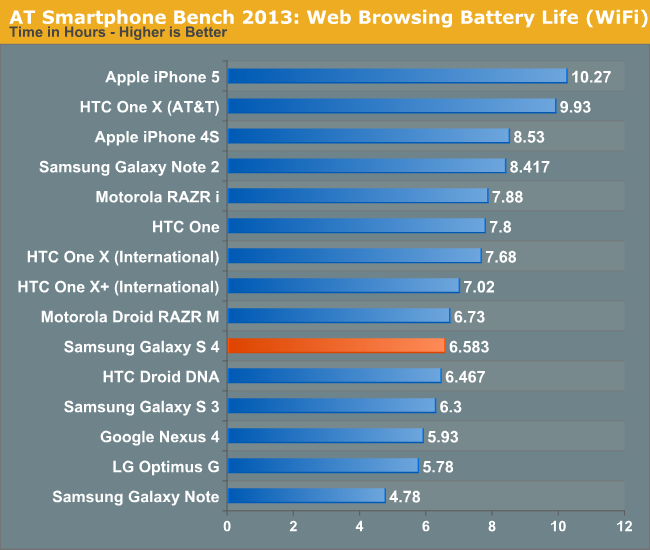
On WiFi the Galaxy S 4 falls behind the HTC One by an appreciable amount, however there's still an improvement in battery life compared to the Galaxy S 3. The Galaxy S 4's battery life isn't bad by any means, but do keep in mind that this is a large phone with a large display and a very powerful SoC. For much of the past year we've been talking about an increase in dynamic range in total platform power of high end smartphones and the Galaxy S 4 is no exception. Run it at full brightness or keep many cores running in their maximum performance states for a considerable period of time and you'll be greeted by a phone that's quickly in need of a power outlet.
As I mentioned earlier, we only have access to the Sprint version of the Galaxy S 4 at this point which unfortunately means that our 3G results aren't all that comparable to other devices here.

Even on Sprint, the Galaxy S 4 does surprisingly well.
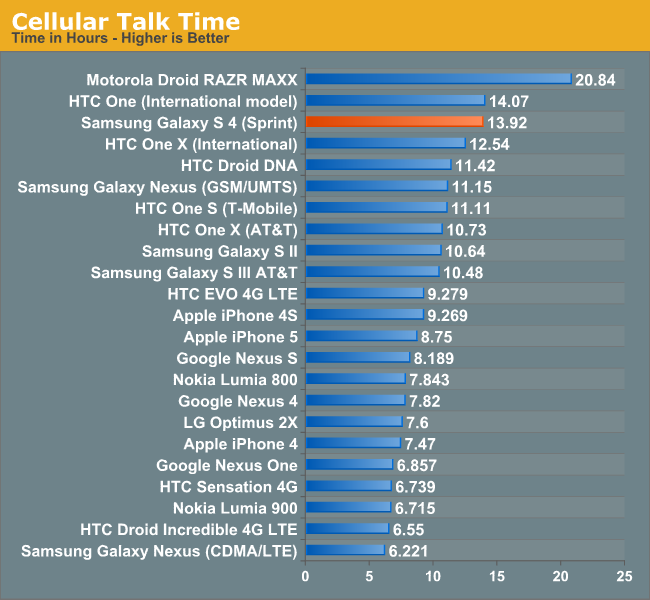
Talk time is excellent on the Galaxy S 4, with the phone delivering effectively the same battery life as the HTC One. Without having to power on that huge display, the Galaxy S 4 can last for a very long time on a single charge.
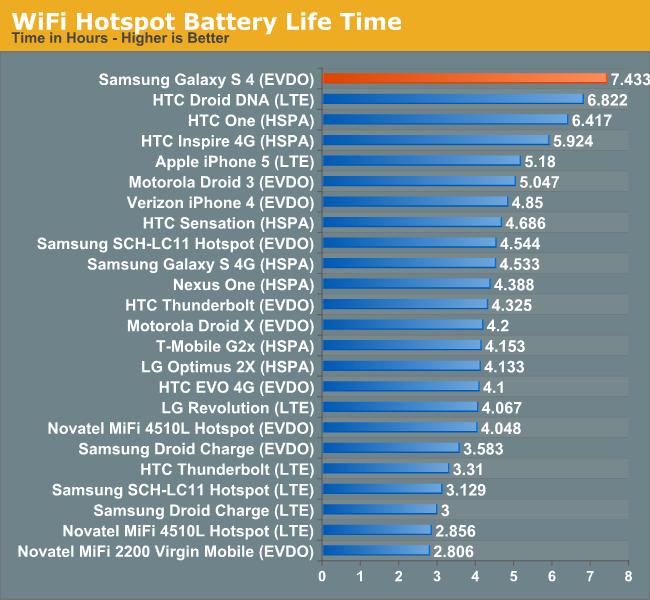
A combination of the Sprint network and the fact that the Galaxy S 4's display remains off during our hotspot test resulted in great battery life here as well. Again, this data isn't all that useful if you're not on Sprint but Samsung tells us we should be able to get our hands on an AT&T SGS4 in the not too distant future.
Charge Time
Samsung appears to implement Qualcomm's Quick Charge specification in the Galaxy S 4 and its bundled charger. I realize we haven't done a deep dive into what Quick Charge is and how it works, but I'll try to go through a quick explanation here. Most conventional chargers are linear, they take a fixed amount of input current (at 5V) and pass it along to the device being charged. The problem is that at deeply discharged states, the device's battery might be at a substantially lower voltage. A traditional linear charger won't change the current supplied based on the voltage of the battery being charged, and as a result can deliver sub-optimal charge times. When implemented, Qualcomm's Quick Charge technology can vary output current based on the voltage of the battery being charged, which results in less power being dissipated as heat and more being delivered to charging the battery itself. The table below helps illustrate the savings:
Quick Charge, at least in its currently available 1.0 specification, is still bound by the 5V limits of the USB BC 1.2 specification. The next revision of Quick Charge will enable higher voltage operation for even faster charge times.
| Qualcomm Quick Charge 1.0, Theoretical Example | ||||||
| Input Current @ Voltage | Input Power | Output Current @ Discharged Battery Voltage | Output Power | |||
| USB BC 1.2 - Linear Charger | 475mA @ 5V | 2.375W | 475mA @ 3V | 1.425W | ||
| Qualcomm Quick Charge 1.0 | 475mA @ 5V | 2.375W | 700mA @ 3V | 2.100W | ||
The non-linear nature of Quick Charge significantly shortens charge time, particularly in the very early stages of charging when the device's battery is presumably fully discharged. As the device's battery voltage increases, current delivery tapers off and the QC advantage is no longer as great as a standard USB BC 1.2 solution. The end result though is significantly improved charge times.
The graph below shows the benefits of using Samsung's own charger vs. a standard charger that implements the USB BC 1.2 specification. When used with the bundled charger, the Galaxy S 4 recharges much faster than HTC's One, despite using a larger battery. Obviously the Galaxy S 4 will charge with any USB charger, but the charge time will simply be longer. Samsung uses a voltage divider and signals the presence of their own charger by sending 1.2-1.3 V across the D+ / D- pins, this is similar to what Apple does with 2.0 or 2.8 V across the pins for various USB chargers they've shipped over the years. This signaling is essentially Samsung's proprietary tablet charging signaling which they've employed on the Galaxy Note 2 and now SGS4, in fact the two use the same exact charger, so it's worth tossing out your old ones and getting the appropriate one to take advantage of the faster charging.
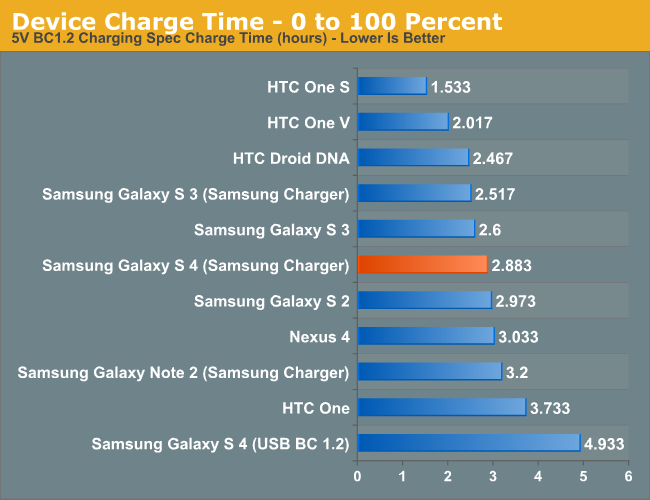


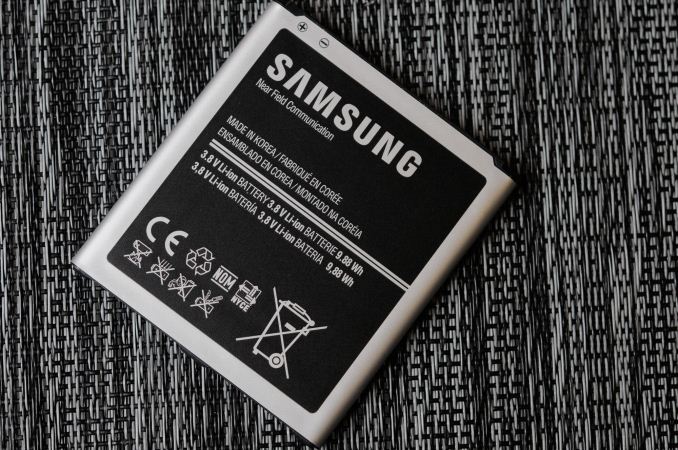








335 Comments
View All Comments
superflex - Friday, May 3, 2013 - link
Quit being a drama queen.My three year old HTC EVO 4G has the original battery and still gets me through a day just fine.
xaml - Friday, April 26, 2013 - link
This is one beautiful device, if you can't see that and you're trying to blame the materials for it, I'm sorry but it shows.Random Kkkkk - Friday, April 26, 2013 - link
" what will probably be 2013's most popular smartphone" Did you somehow forget about Apples iPhone 5? You can't be serious if you think this will outsell it considering the iPhone 5 has had a quarter of sales already.Spikey01 - Friday, April 26, 2013 - link
There is a difference between popular and units sold...The S4 will be a huge sucess!!
medi02 - Sunday, April 28, 2013 - link
Check charts on these page:http://tech.fortune.cnn.com/2013/03/16/apple-iphon...
Galaxy is only slightly behind iphone sales, on the other hand, its sales were doubling with every release.
puremind - Friday, April 26, 2013 - link
Brian, what color meter do you use for display checks? The color temperature on the HTC One in your comparison seems like an overestimation. In my measurements, it should be 7200K for the Taiwan factory (serial numbers starting with HT) and 6670K for the Argentina factory (serial number starting with FA).It does not change the results, though, seeing as all your phones are measured with the same color meter, this is still a fair comparison.
Just to give you an idea, on the HTC One, the Eye One Display Pro overstimates color temperature by up 500K depending on the spectral profile used, the Spyder 4 usually overestimates even more.
When I look at the color temperature values for the other LCD phones, it also looks to me like there is a 500K overestimation as well compared to what I have seen elsewhere. This is also why we see wild fluctuations of color temperature across all reviews.
Could you maybe post the first two letters of the serial number of your HTC One unit, as it could be yet another factory with a different screen calibration. Either way I am curious about this.
Of course even a spectro like the i1 Pro 2 has a temperature shift of up to 300K upwards depending the point of initialization. Again, the comparision still holds because the same method and instrument was used for all phones, and usually even if some color meters have errors in color temperature readings, the rest of the spectrum is usually read correctly on those newer devices.
mike 3283 - Friday, April 26, 2013 - link
ok people just to shut all of of you up about the aluminum htc one. samsung is already in the works making their next phones metal.including a metal s4 later this year. and also dustproof and waterproof s4 too. So when the phone that's better in every way already except it's plastic will murder the htc. listen the s4 is selling ten million units to htc's 2 million. So wait till the s4 is metal. then what? then everyone who gets the htc now will be wishing they hadn't. come on the s4 is way ahead of htc. it has so much more to offer. all the extra features and gorilla glass3 which is way stronger and ddr3 memory which is faster and uses less power. all the accessories coming out for the s4. expansion of memory and removable battery. and not to mention the repairability of the s4 kills the htc. if you break anything on the one you are screwed. there's no replacing a cracked screen. if you even try to take the glass off you will ruin the phone. check out the review on ifixit for the htc. worst rated phone to repair ever. s4 rated easiest to repair. htc tried but failed. and anyone who says they are buying the metal htc because it's more durable is an idiot. they are buying it so they can brag to their friends and say look at my phone. it's htc. it's just a boring phone with no wow factor except the body which is useless. their blinkfeed is a ripoff of Windows tiles and flipboard both of which are better. as far as phones go htc has high end hardware but anyone can put that on phone. there are all kinds of companies that have the same stuff as htc coming out on their phones. but samsung at least has innovations with that hardware. That's why they will flat out sell htc 5 to 1 if not more.in fact they are probably going to beat iphone sales for a 3 month period. New record coming and its plastic. OMG! HTC ONE will fail just like every other htc that had ever tried. they just don't have what it takes. and their stupid speakers on the front ate worthless. nobody ever listens to their phone out loud or if they do its for a very short time. in headphones is where it matters and s4 has a wolfson chip which is the best sound chip in the biz. So as a conclusion s4 wins htc loses. That's life. htc one x failed to the s3 so how well this be any different. it won't it will be even worse.fackamato - Friday, April 26, 2013 - link
Do you have to try really hard to write such useless, false and unreadable posts or does it come naturally to you?bhima - Saturday, April 27, 2013 - link
It isn't just the fit and finish of the htc one... the camera is the most useful camera in real world lighting scenarios. If it had a removeable battery, I'd have already bought it.gaasedal - Friday, April 26, 2013 - link
Thanks Samsung for keeping the plastic back plate:) I don't care if it is plastic, alu or paper, as long it is light weighted. I have an HTC Desire HD and I don't want a heavy smartphone again, and I want to insert a 64GB MicroSD card and I want to be able to change the battery.SG4 is better than HTC One in all parts.
On monday I will have a new SG4 :)